Auto Aftermarket Retailers: The Impact Of Amazon And Why AM/FM Radio And Podcasts Are The Ideal Marketing Platforms For The Category
For the fourth year, CUMULUS MEDIA | Westwood One commissioned MARU/Matchbox to conduct an annual study of the auto aftermarket category to determine the current state of America’s auto parts retailers. 805 auto parts shoppers were surveyed in April 2021.
Key segments: Do-it-yourselfers and ultra-heavy auto parts shoppers
16% of auto parts category shoppers are do-it-yourselfers, spending +44% more than the average. Mega-milers clock 200+ miles in their vehicles a week and spend +50% more on auto parts than the average.
Ultra-heavy auto parts shoppers have made 10+ shopping trips in the past two years. They comprise 21% of category shoppers and represent 56% of all category shopping trips. They spend +60% more than the average.
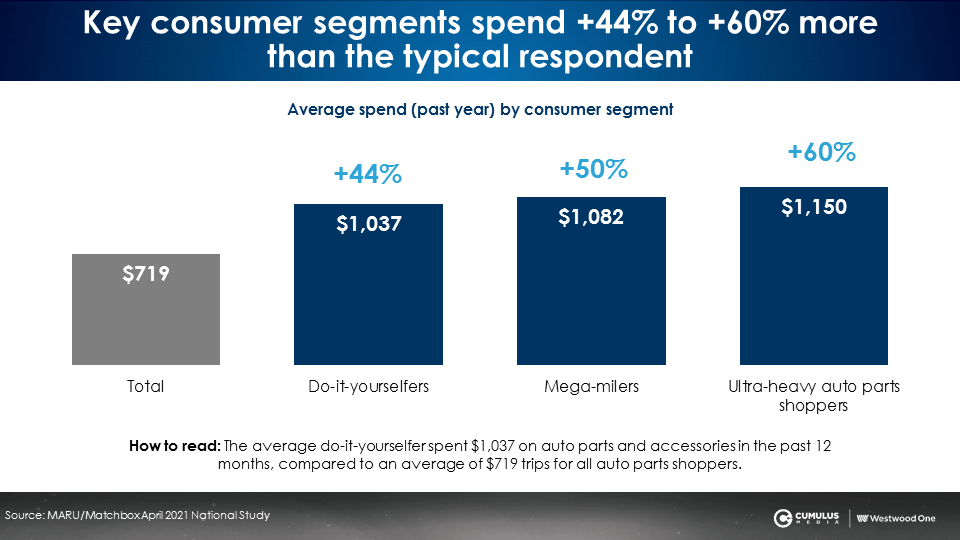
Pros represent one out of six ultra-heavy shoppers and mega-milers and over one out of four do-it-yourselfers
Those who repair or maintain cars full-time or part-time represent 28% of do-it-yourselfers and 15% of ultra-heavy auto parts shoppers. Pros would be an ideal media target.
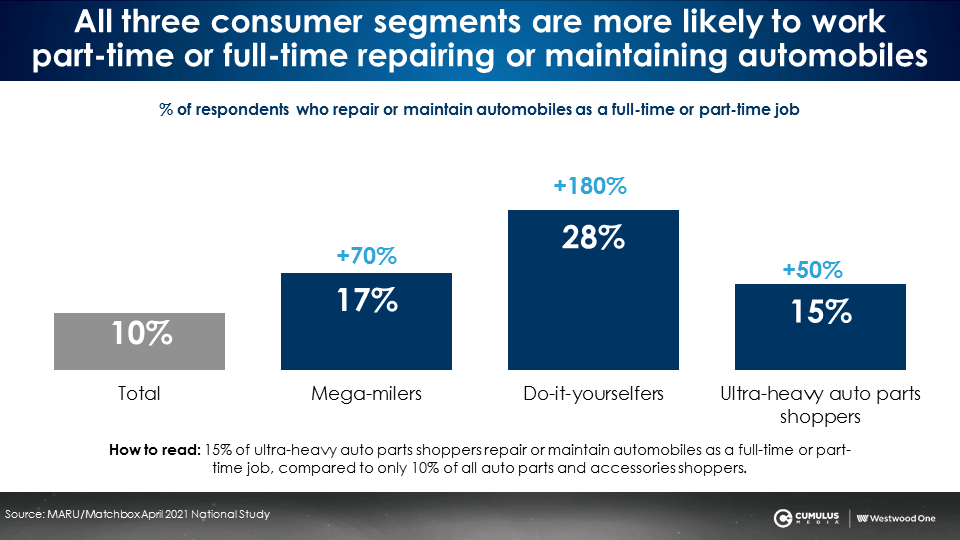
Media scorecard: AM/FM radio and podcasts are the ideal platforms to advertise auto aftermarket
Heavy AM/FM radio listeners and podcast listeners visit more retailers, make more shopping trips, and spend more annually in the auto parts category.
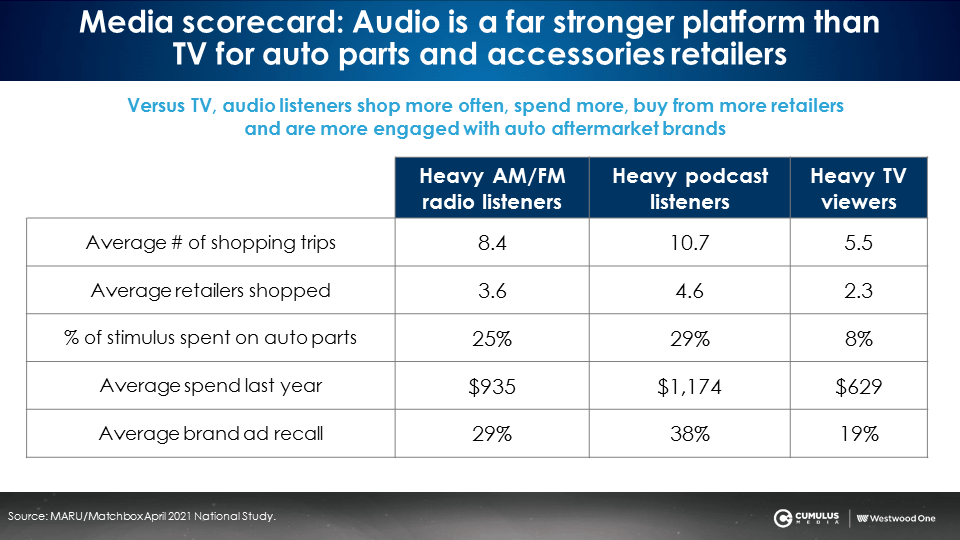
Compared to heavy TV viewers, audio listeners:
- Shop twice as often
- Shop more auto parts retailers
- Spent a far greater proportion of their government stimulus payments on auto parts
- Spend more each year
- Exhibit higher ad recall
AM/FM radio and podcasts are the soundtrack of the American worker. Transportation to work is vital, so auto parts are an investment in getting to work. Conversely, TV is the soundtrack of America’s retirees. Only a small percentage of heavy TV viewers spent stimulus funds on auto parts.
Media allocation mismatch: While heavy auto parts shoppers are twice as likely to be heavy AM/FM radio listeners versus TV viewers, only 20% of media spend is allocated to AM/FM radio
Linear TV is over-planned. AM/FM radio is under-allocated. Kantar and Miller Kaplan report 80% of 2020 category spending occurred on TV. Only 20% occurred on AM/FM radio. Based on purchase data, the ideal auto parts retailer media allocation should be 60% AM/FM radio and 40% linear TV.
Heavy TV viewers are light users of the auto parts, under-indexing on spend, retailers shopped, and brand images. Heavy AM/FM radio listeners are massive users of the category, spending more and having higher engagement with auto parts brands.
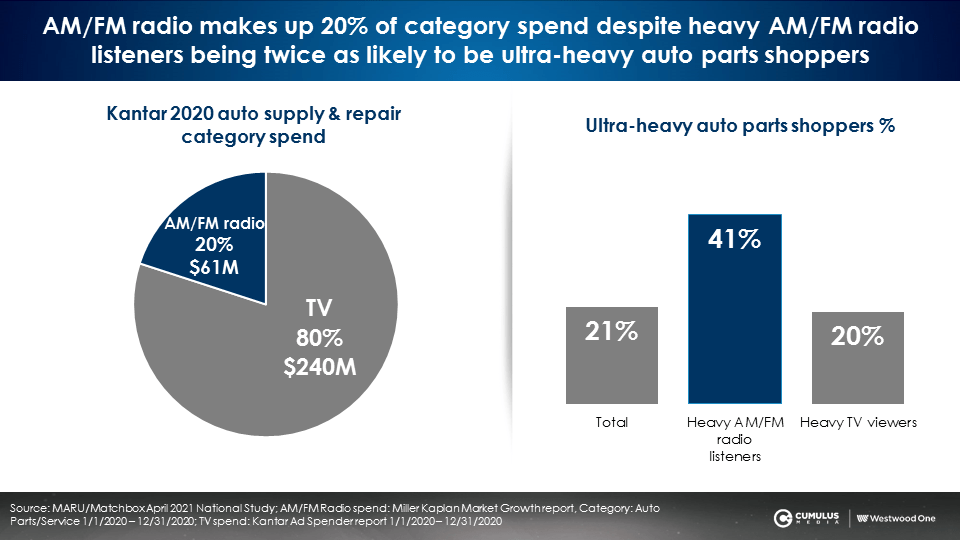
AM/FM radio’s best listeners are also the biggest customers for auto parts retailers: Key auto parts shopper segments are far more likely to be heavy AM/FM radio listeners
The three key consumer segments, mega-milers, do-it-yourselfers, and ultra-heavy auto parts shoppers, are more likely to be heavy AM/FM radio listeners:
- Ultra-heavy auto parts shoppers, those who made 10+ shopping trips in the past two years, are +78% more likely to be heavy AM/FM radio listeners
- Do-it-yourselfers are +83% more likely to be heavy AM/FM radio listeners
- Mega-milers are +43% more likely to be heavy AM/FM radio listeners
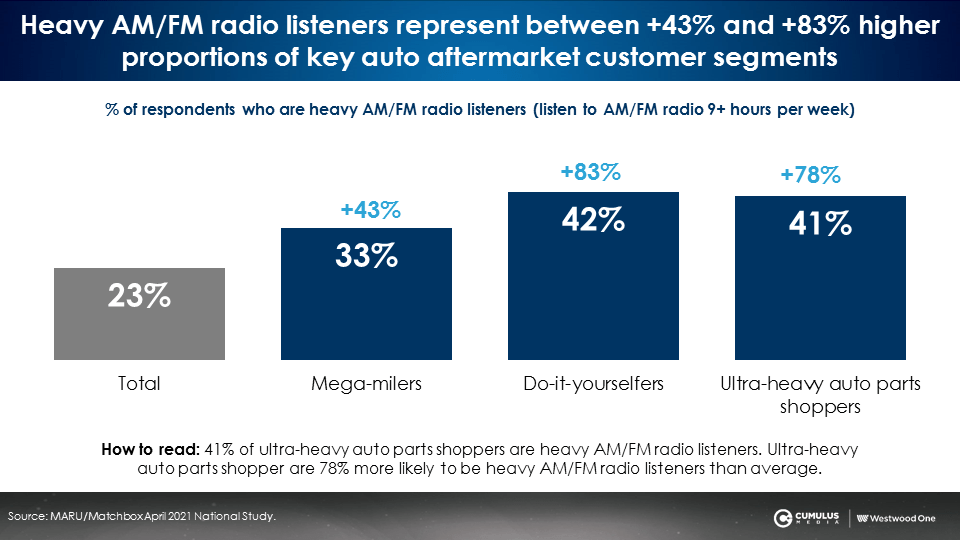
Time spent in the car powers AM/FM radio listening and the need for auto parts
As time spent in the car grows, so does the need for car maintenance and auto parts. As such, the heaviest AM/FM radio listeners are the biggest auto parts shoppers. AM/FM radio is endemic to the auto parts category.
In the car, AM/FM radio is the “queen of the road” with a stunning 87% share of ad-supported audio
Edison Research’s just-released Q2 2021 “Share of Ear” report reveals AM/FM radio has a dominant share of in-car ad supported audio. AM/FM radio is the perfect platform to reach heavy auto parts purchasers when they are in the car and their thoughts turn to car maintenance.
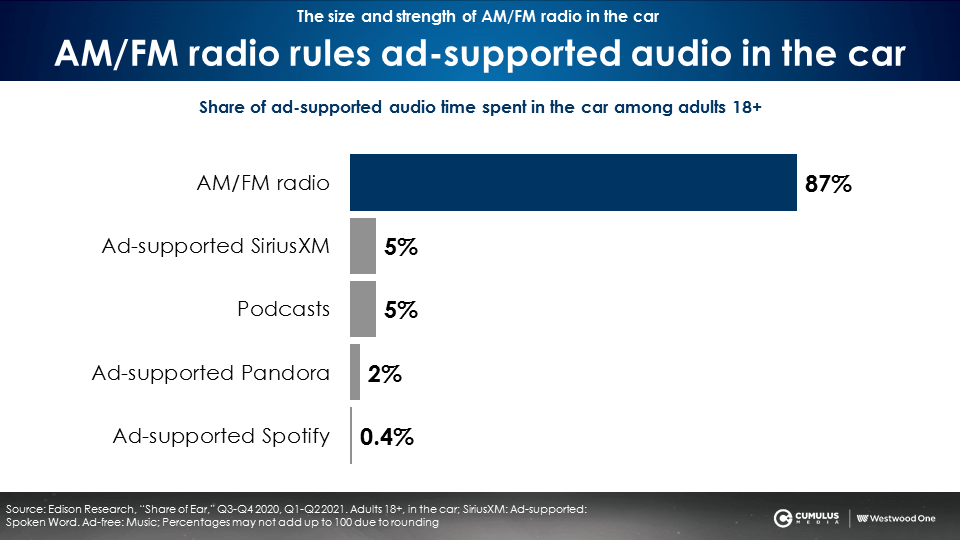
A wide variety of AM/FM radio programming formats and podcast genres generate strong reach with auto parts purchasers
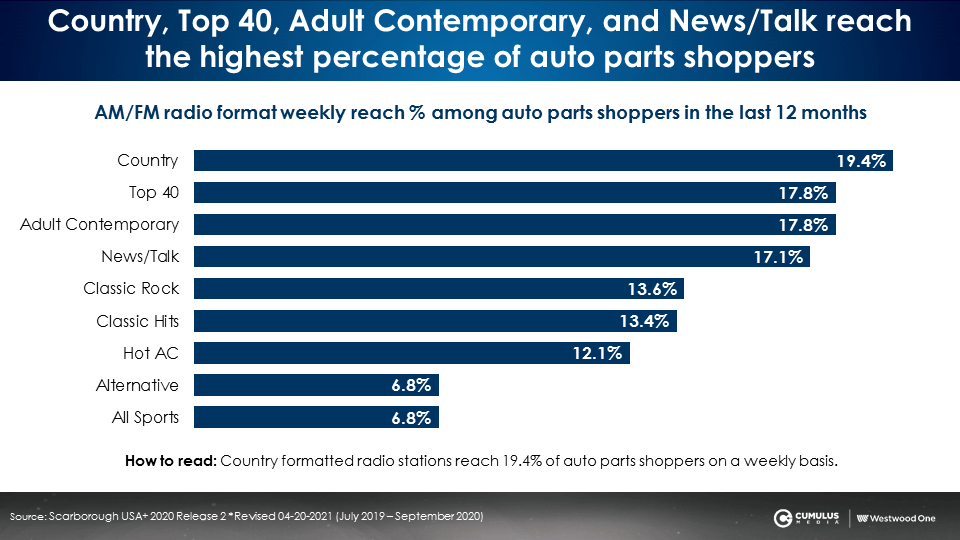
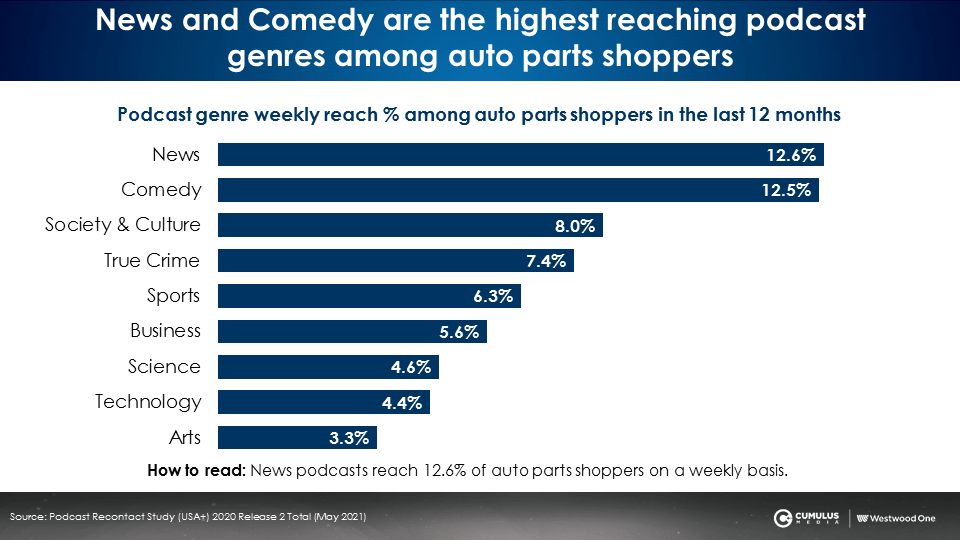
Half of auto parts shoppers use both online/discount outlets and traditional retailers
Traditional retailers include Advance Auto Parts, AutoZone, O’Reilly Auto Parts, Firestone Complete Auto Care, NAPA Auto Parts, and Pep Boys. Online and discount retailers consist of Amazon, Walmart, Costco, RockAuto, and PartsGeek.
37% shop only in the traditional retail channel. 14% only shop via online and discount outlets. Half shop both retail channels.
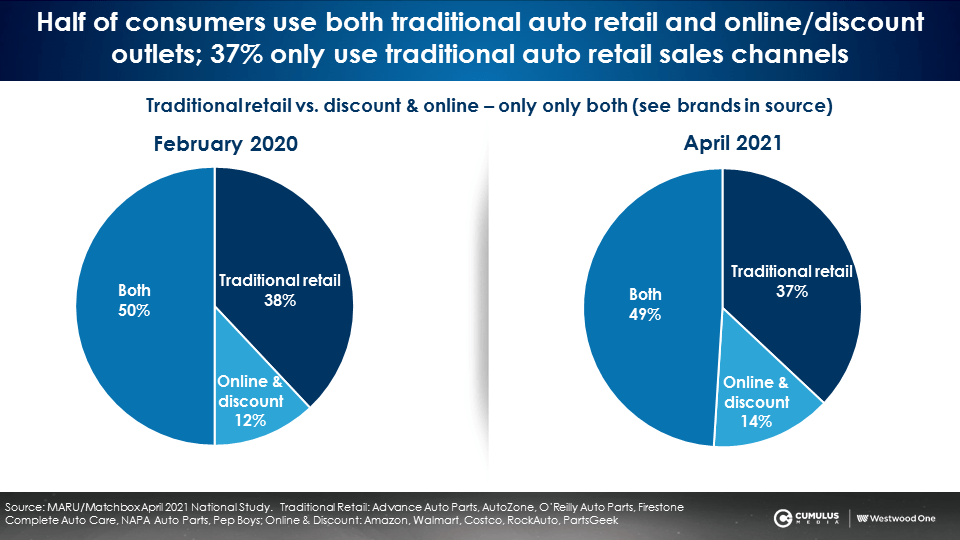
Shopping preference: AutoZone leads but Amazon now ties with Walmart for number two while the remainder of brands hold steady
24% of consumers say they shopped most in the past year at AutoZone, one of the first major national auto parts retailers. Amazon ties with Walmart at a 14% share for “shopped most often.”
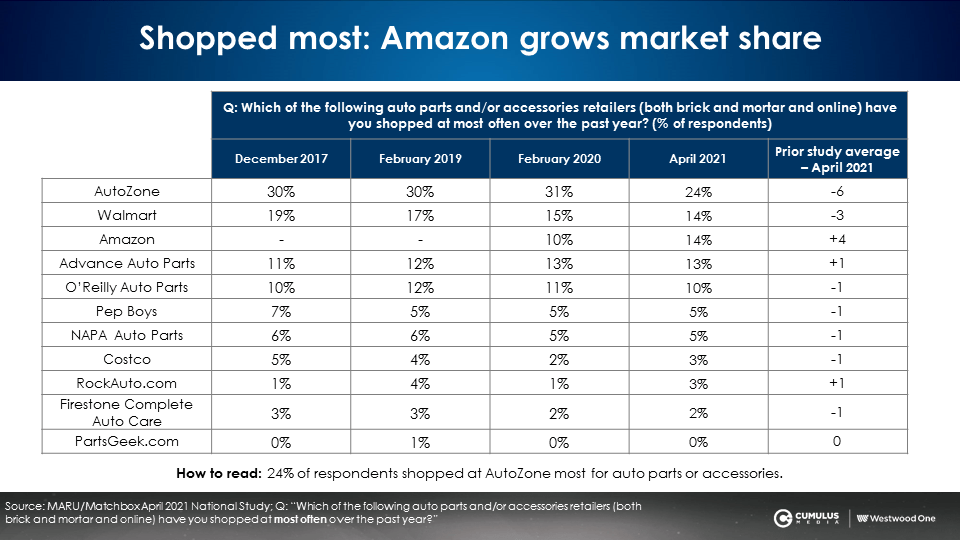
Brand equity: AutoZone leads, followed by Advance Auto Parts, Walmart, O’Reilly Auto Parts, Amazon, and NAPA Auto Parts
Twenty different brand attributes were measured such as ‘has the most convenient locations,’ ‘has the most knowledgeable and helpful staff,’ etc. Consumers were asked to name the retailer that first came to mind for each attribute. The average of these twenty retailer associations creates the average brand perception.
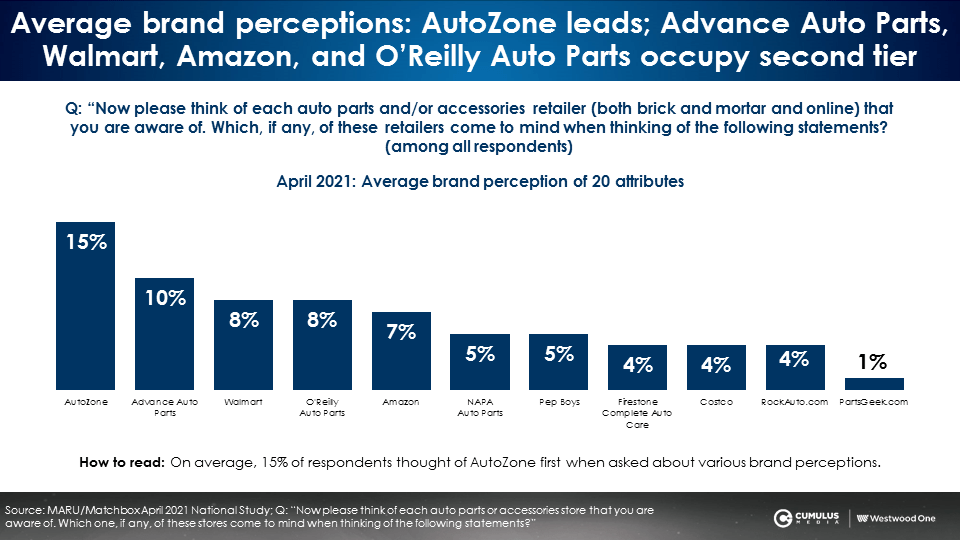
Service offerings: Younger demographics say maintenance (oil, fluid changes, battery testing, etc.) are very influential as to which auto parts retailer they choose
Compared to heavy TV viewers, more heavy AM/FM radio and podcast listeners say service offerings are extremely/very influential on their decision for which auto parts retailer they shop.
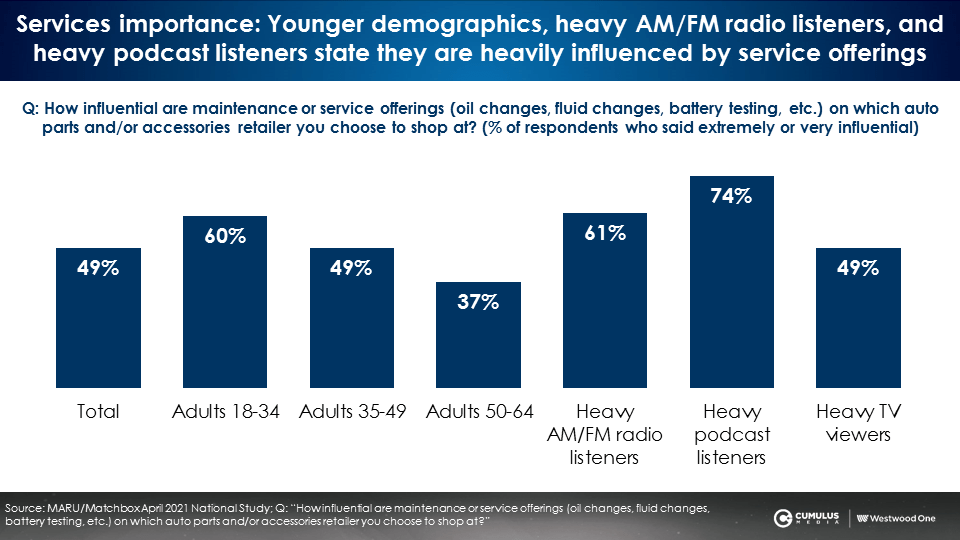
Key findings:
- Consistent trends: Across the last three years, brand equity and shopping patterns have been generally consistent.
- AM/FM radio and podcasts are the ideal platforms to advertise in the auto aftermarket category: Heavy AM/FM radio and podcast listeners visit more retailers in the category, make more shopping trips, and spend far more than the average. Two key consumer segments, do-it-yourselfers and ultra-heavy auto parts shoppers, are far more likely to be heavy AM/FM radio listeners. TV viewers are very low category users.
- Amazon’s strength: 35% of consumers have shopped at Amazon in the last year (included in this study for the first time in 2020) and 14% say they shop Amazon most. Among the key do-it-yourselfer and ultra-heavy auto parts shopper segments, Amazon is number one and two in brand equity and shopping.
- Brand opportunity: 27% of category shoppers cannot attribute perceptions to any retailer.
- Services are a young demographic strategy: 60% of adults 18-34 say maintenance or service offerings (oil changes, fluid changes, battery testing, etc.) are extremely or very influential in deciding which auto parts and/or accessories retailer they choose for shopping.
Recommendations:
- Build brands too: Historically, the auto aftermarket sector heavily marketed special offers. There is a significant body of marketing research that indicates “a succession of short-term response-focused (offer) campaigns will not succeed as strongly over the longer term as a single brand-building campaign designed to achieve year-on-year improvement to business success.” (Binet & Field)
- Market online shopping: Consumers are transitioning to a blend of retail and online shopping for their auto parts needs. Legacy brands need to adapt to changing shopping habits and market their online platforms to consumers.
- Target pros: Given that pros represent a strong proportion of do-it-yourselfers and ultra-heavy auto parts shoppers, the pros segment appears to deserve some creative and targeting focus.
- Maintain AM/FM radio as the centerpiece of the media plan: AM/FM radio is the engine of auto aftermarket sales. Nielsen determined AM/FM radio generates $21 of return in advertising spend for every dollar invested in AM/FM radio ads. Key auto aftermarket segments (mega-milers, do-it-yourselfers, and ultra-heavy auto parts shoppers) are heavy users of AM/FM radio. Reallocation of TV budgets to audio is a smart strategy to target heavy category users.
Justin Thomas is a Research Analyst at Westwood One.
Contact the Insights team at CorpMarketing@westwoodone.com.